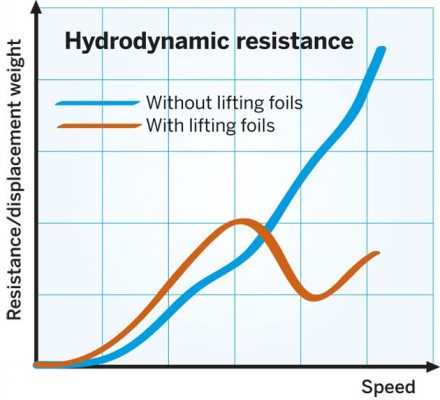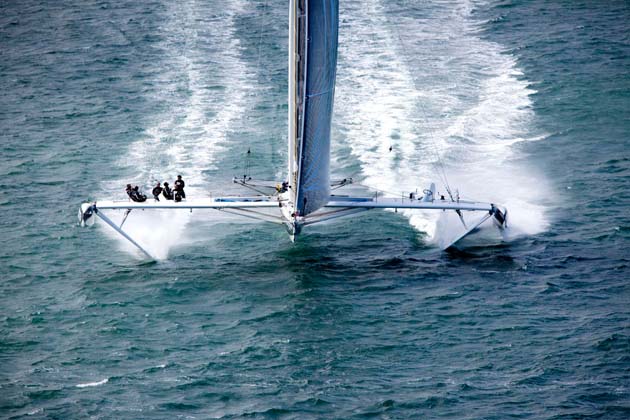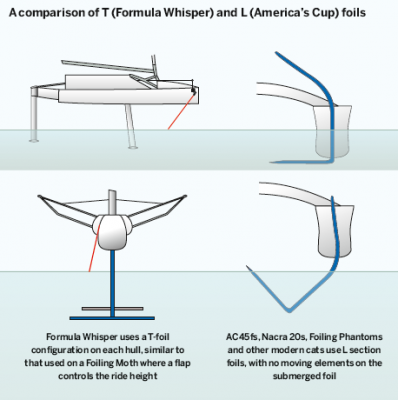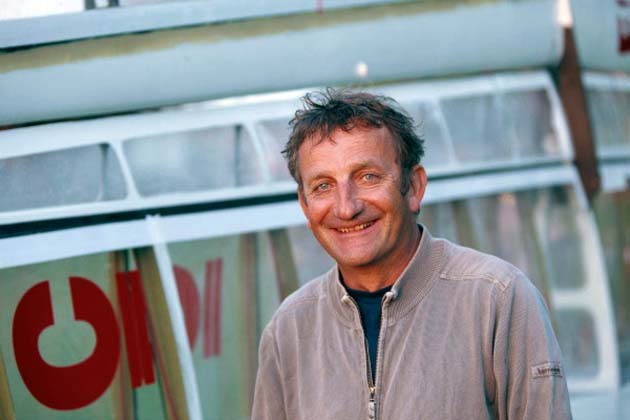The biggest revolution to hit watersports has been foiling, but how did it start and what are the issues involved? Matthew Sheahan investigates
Here’s a challenge. Design a way to support the weight of five saloon cars on a plate the size of your desk on the water. That was the task that faced America’s Cup designers in their bid to make the new breed of foiling America’s Cup boats fly.
If that’s a bit tough, here’s an alternative. Support a 70kg person and their boat in the water on a plank the size of a cricket bat. This one is much easier, the GCSE of hydrodynamics by comparison, with plenty of examples as to how it can be done thanks to the proliferation of foiling Moths around the world.
Getting boats to fly above the water surface is simple in theory, but tricky in practice and has challenged designers for over a century, but in the last decade one class appears to have cracked it.
On the face of it, International Moths on hydrofoils are sailing’s answer to the unicycle. But Moth sailors are far from being trick cyclists, there is a serious side to all this. A foiling Moth will reach 14 knots upwind and 20 knots downwind in just ten knots of wind, and in 20 knots of breeze they’ll be cranking along at 17 knots upwind and 25-30 knots down.

The International Moth has done more than any class to raise the profile of sailing hydrofoils. Photo: Thierry Martinez/Sea&Co
Whether you’ve seen the pictures or experienced the ghost-like whistle followed by the eerie vacuum that trails behind as they come slicing past, it is clear the Moth fleet has done much to publicise the thrill, grace and speed of sailing hydrofoils. The rapid growth of the class has also shown us that foiling is not just for pioneers and record breakers, but that despite several failed attempts in the past to bring it to the masses, this time there just might be a future in foiling.
Another reason why this particular class has exerted so much influence in sailing and spawned a new cycle of design is that Moths can race as a fleet round a course, foiling upwind and down. Although there are plenty of other boats that foil, most have a limited sailing repertoire and need specific conditions to fly. A Moth can fly on all points of sail and is capable of tacking and gybing too.
This has been one of the biggest steps forwards and has helped to boost recent interest from designers and sailors for other potential foiling projects.
Foiling, it’s a drag
At high speed, drag and seakeeping become big issues aboard any vessel, particularly offshore monohulls, and while yacht design has made some big steps forward since the days of hauling half the ocean behind in a pair of breaking quarter waves, there are other issues holding back performance.
Razor-straight wakes ironed flat by beamy after sections are clearly a step forward. Yet the problem for monohulls is that, as they slam and crash their way into the waves, keeping the structure in one piece is a big challenge. Rising above the water’s surface not only reduces drag, but might help to reduce structural risks and make handling at speed easier.
Forty years ago it looked as though offshore foiling was about to make a breakthrough. David Keiper took the concept cruising in the 1970s with his trimaran Williwaw (see below), in which he clocked up a staggering 20,000 miles cruising the South Pacific. A decade later, French sailing legend Eric Tabarly broke the schooner Atlantic’s west to east transatlantic record set by Charlie Barr in his foiling trimaran Paul-Ricard.
Yet despite such feats, offshore foiling stalled. Tripping up at speed and keeping the boat in one piece when it touches back down have been the main concerns. And while neither of these two pioneers suffered such a fate, there are plenty of wince-inducing reminders of how it can all go pear-shaped.
But today foiling is more popular than ever. The French tri-foiler and former world record holder L’Hydroptère was the first sailing boat to break through the 50-knot barrier. Since then, a new world record has been set by Paul Larsen’s Sailrocket, another foiler, albeit an extreme one, which owes its success to a recent breakthrough in hydrodynamics.
Both share a longer-term view of taking foiling offshore. So does the British foiling cat project C-Fly with its canard configuration.
Meanwhile, the America’s Cup cats are trying to scorch around an inshore racecourse on foils that have no moving control surfaces. It’s a big ask of a high-speed boat and there have been spectacular crashes.
Then there’s SYZ&Co, the 35ft foiling cat on Lake Geneva, the new L’Hydroptère.ch, as well as the hull-less Mirabaud LX. These are just a few of the better known foiling projects, but plenty of others are experimenting with hydrofoils in subtler, more discreet ways – and not just racers and record-breakers.
Foils not just for the few
Cruising catamaran manufacturers Catana launched a 59ft luxury cruising cat that has curved daggerboards that the builders claim produce half a tonne of lift at ten knots. The Dynamic Stability System (DSS), which uses a hydrofoil in the horizontal plane, doesn’t aim to raise the boat out of the water, but instead uses hydrodynamic lift to improve its performance – although the new Quant 23, claimed to be the first foiling keelboat, uses the DSS is a new and thrilling way.
And then there are those who seek to bring the thrills of hydrofoils to the average sailor. In quick succession there have been a couple of 36ft Infiniti multihulls, the Flying Phantom, the Gunboat foiling 40ft G4 and the Formula Whisper foiling catamaran, possibly the first foiler designed for club sailors. There has even been a first Foiling Week in July 2014, where a number of different foiling boats strutted their stuff.
Foiling is in vogue and capturing people’s imagination. But apart from the Moth sensation, why is foiling so popular now and where is this all leading?
Material advances
As is so often the case, the answer lies in the development of new materials and techniques. Weight and strength is at the heart of the issue and carbon has once again played a big part.
While foiling clearly appears to reduce the wave-making drag considerably, there is no free lunch. Lift and drag go hand in hand and what happens beneath the surface can sometimes wipe out any benefit above. For example, tilting a foil at a large angle of attack may create lift, but there will often be a large amount of drag too.
“You don’t fly for the beauty of it,” says aeronautical engineer Joseph Ozanne, Oracle’s lead wing designer for the two previous America’s Cup cycles. “People forget that to generate sufficient lift to raise an entire boat can mean introducing a lot of drag. Just because you’re flying doesn’t mean you’re suddenly more efficient or faster.”
To test this, put your hand horizontally outside a car window while it’s going along and rotate it gradually. Initially, with a small angle of attack, your hand will want to rise, but as you twist your palm further, the force pulling it backwards increases significantly.
It’s the same with foils; you can generate lift at high angles of attack, but you won’t necessarily be going any quicker simply because you’ve lifted out of the water.
30kg all up
As a generalisation, less weight means less vertical force is required, which means small angles of attack, which in turn means low drag. From here it’s easy to see how modern materials and the dramatic reduction in the all-up weight of modern boats has helped to make hydrofoils more feasible. Taken to extremes, a modern Moth weighs just 30kg all-up, less than half the weight of its crew.
But the theory doesn’t work for all lightweight, powerful boats; there is a limit.
“Back in 2006 when we were designing Mike Golding’s Gamesa, we looked into the possibility of a fully foiling Open 60,” reveals designer Merfyn Owen. “An Open 60 is a pretty powerful boat and when you compare the sail area:displacement ratio with that of a Moth there appears to be evidence that a foiling 60 could work.
“The trouble is that, unlike a dinghy where the crew generates huge righting moment when compared to the weight of the boat by sitting it out, on an Open 60 the rules on stability prevent you from generating enough righting moment to get the boat fully up on its foils. The Open 60 also has a wide draggy hull compared with a Moth with lots of wetted surface area that holds you back.”
So if an Open 60 would struggle to get up, the prospect for other large foiling monohull keelboats is looking doubtful.
Multihulls, on the other hand, are lighter for the same length and sail area and can generate huge amounts of righting moment without putting on weight, thanks to their wide beam. This makes them better suited to hydrofoils. But there are other problems to overcome and several key configurations to consider.
Foiling configurations
The first issue is how much foil surface area you need to lift the boat. This varies with speed: the faster you go, the less you need. Early foil design used ladder-type racks of foils which lifted out of the water as the boat went faster, reducing the number of immersed foils as the speed increased. But this comes with a big drag penalty at slow speeds.
Surface-piercing configurations, where the foils are angled in a V shape, also find their own natural ride height depending on the speed. As the boat accelerates, the foils generate more lift, raising the boat, which in turn reduces the amount of foil in the water until equilibrium is achieved. The boat finds its own ride height automatically, with no moving parts required.
The configuration works in a similar manner with heel. As the boat heels to one side, more foil is immersed on the leeward side – and less to windward – which helps to right the boat. This inherent stability makes the surface-piercing configuration a popular one – it can be seen on boats like L’Hydroptère. But the problem comes at slow speeds when the high drag of the fully immersed foils hampers performance.
Fully submerged foils, where the lifting part of the arrangement is a horizontal foil mounted under the water at the bottom of a vertical strut, offer the lowest drag, but they have to incorporate an additional element to control the ride height. In other words, the foil has to change its lift characteristics depending on speed.
To do this, the horizontal foil has a moving element on its trailing edge like an aircraft’s elevator. In the case of the Moth, this elevator is connected mechanically to a ride height sensor, a wand that skims across the water’s surface. The lower the boat is travelling above the water, the more the elevator is deployed, creating more lift. But as the boat accelerates the lift increases and it starts to rise. The wand then takes up a different angle from the water’s surface and reduces the deflection of the elevator, reducing the lift.
Apart from the difficulty of following the sea’s surface in big waves, the problem for most sailing boats, especially keelboats, is that this configuration doesn’t provide any athwartships stability. The Moth stays upright because its crew hikes to windward. The same is true for other dinghies and cats that use crew weight for righting moment. On monohulls it’s difficult to make the configuration work.
‘C’, ‘L’ and ‘S’ foils
But not everyone wants to fly. In recent years there has been a great deal of development in foils with complex shapes from ‘C’ shapes, to ‘L’ and ‘S’ shapes and now ‘S’ foils with winglets. Generally speaking, these foils are less concerned with flying and more with the balance between generating sideways lift to drive you upwind and vertical lift to reduce displacement. Much of this development work took place in the former ORMA 60 multihulls.
“By canting the leeward daggerboard you can change the balance between lateral and vertical lift,” explains Vincent Lauriot-Prévost of designers VPLP, experts in high-performance multihulls and some of the world’s more extreme designs such as USA-17 and L’Hydroptère.
“When you’re sailing upwind, side force from the daggerboard is very important, as it is in any boat, but as you sail freer and faster you need less foil to create the required side force. Normally you would lift the board to reduce the drag, but if you leave it down and then cant it in towards the centreline, you create some vertical lift which then helps to reduce the displacement of the boat.
“Another way to achieve a similar effect is to have a curved daggerboard. A simple ‘C’ shape provides more vertical lift the further it is pushed down. The next stage of development was then to try ‘S’ shaped boards which, again, vary the distribution of lift and side force depending on where the boards are set.”
Although more expensive to build than straight boards, curved daggerboards have the advantage that they do not need complex canting mechanisms. Some classes and rules ban the latter so this is an alternative approach.
“Our ORMA 60 design Gitana II, which won the Route du Rhum in 2006, would see a reduction in displacement of 40 per cent at 20 knots,” says Lauriot Prévost. “At 26-28 knots the displacement would reduce to 70-75 per cent for a boat that weighs 6.5 tonnes fully loaded.”
This puts the issue of displacement reduction into perspective for cruising boats. Half a tonne of lift at ten knots from a curved daggerboard might sound a lot, but when the boat displaces 22 tonnes loaded, the displacement reduction is just over two per cent. While this may still have a beneficial effect on performance, it becomes easier to see that the future for cruising hydrofoils is not so clear cut.
Changes to trim, stability and displacement through subtle alterations in the alignment of foils is also a growing trend in the Open 60s and now the Volvo 65. Angling the keel pin up at its forward end by a few degrees provides a positive angle of attack on the keel fin when canted out to windward. When swung out to one side, the fin acts like an aircraft’s wing and helps to support the boat, although the lift also tends to reduce the effective righting moment.
Nevertheless, according to at least one top designer, the effort is worth it. He says: “There are some other performance details involved with this that I can’t speak about!”
Foils of the future
Where is the current craving for foils taking us? One of the biggest foiling experiments at present is in the America’s Cup. With their notoriously big budgets, Cup campaigns are well-known to accelerate the development of ideas that can eventually trickle down. What kind of technology breakthrough will wingmasted cats on foils provide?
The answer is not a simple one as the AC72s used in the 2013 Cup were never originally intended to foil. A loophole in the rule, exploited by the New Zealand team and deemed legal by the jury, sent teams off exploring the possibilities, but with little scope to control the foils themselves as no moving parts are allowed.

In the 2013 America’s Cup, the Kiwis exploited a loophole in the rule to put their catamaran on foils
“The Kiwis look good on foils, they are stable in pitch and heave and their foils appear to be reliable. But this will all come at a cost: drag,” said Oracle’s Joseph Ozanne at the time. “Less pitch stability, as our boats had, can reduce drag, but it makes the boat very tricky to sail. We did a lot of wheelies when we were learning to sail our boat. Regulating flight height is a nightmare.
“Modern aircraft are designed to be more unstable to improve manoeuvrability and also to reduce drag, but they have systems that keep them under control. We are not allowed these systems, so it’s the crew that have the control. So the key foiling lessons from the Cup could be learning about foil shapes and how to handle instability.”
For Sailrocket II’s foil designer Chris Hornzee-Jones, another aeronautical engineer, hydrofoiling means speed. Having set a new world record at 64.54 knots and broken into new territory, Hornzee-Jones believes this is just the beginning.
“I’m convinced we can get to 70-75 knots with subtle developments to this foil,” he declares. “Beyond that it becomes progressively harder, but the fact that powered craft on foils have achieved 80-100 knots confirms that there are foil shapes that will work at this speed. I think it may be difficult to get a single foil to perform over the entire speed range. We already use two on Sailrocket. Nevertheless, I do see over 80 knots as possible.”
The lessons learnt in this new speed territory could also have implications at far slower speeds and for much less extreme boats.
“Thick foils like the one we developed are good structurally,” says Hornzee-Jones. “Creating a foil that ventilates at low speeds means that at, say, 20 knots you are already into low drag.”
Like a gearbox and engine combination that allows you to engage top gear at 20mph and accelerate though to 100mph without changing gear, versatile, vice-less foils could indeed transform the behaviour of our boats in the future. Add to that the possibility of active control using sophisticated, compact and efficient electronics and new possibilities emerge.
Opening our minds
Although the average cruising monohull may not want to get up and flying, efficient low-drag stabiliser foils, for example, controlled by a tiny chip, could make the notoriously rolly tradewind conditions on a transatlantic a more comfortable and efficient affair.
“Foiling Moths have opened people’s minds,” says Vincent Lauriot-Prévost. “The future will depend on having good control of efficient foils. We will need to change camber profiles effectively and develop automatic trim regulation. But, we must also think weight, otherwise the systems won’t work.”
Perhaps it is no surprise that after more than 70 years of sailing development at the leading edge of the sport, many are still scratching their heads at how to make such a promising concept work for the rest of us.
 If you enjoyed this….
If you enjoyed this….
Yachting World is the world’s leading magazine for bluewater cruisers and offshore sailors. Every month we have inspirational adventures and practical features to help you realise your sailing dreams.Build your knowledge with a subscription delivered to your door. See our latest offers and save at least 30% off the cover price.
















